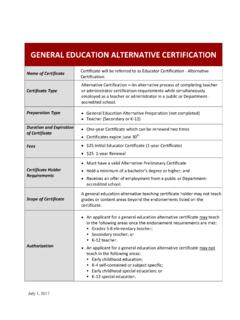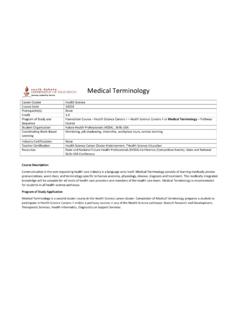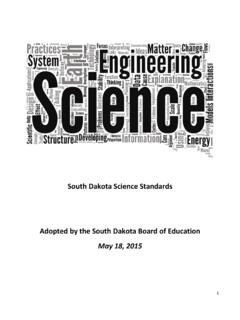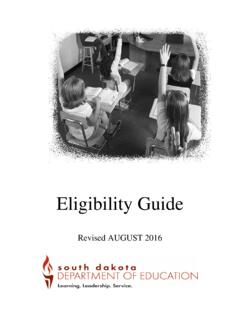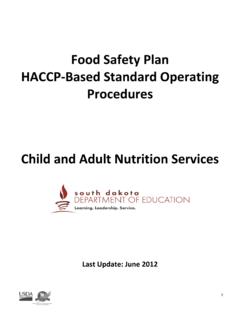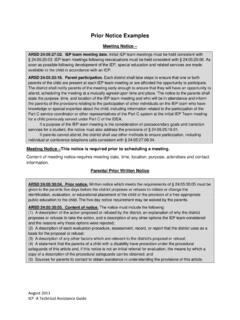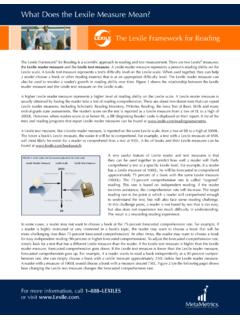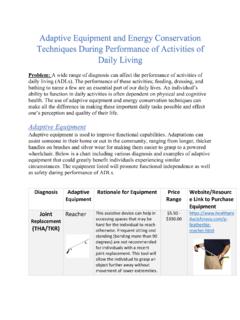Transcription of Food Safety Plan HACCP Standard Operating
1 1 food Safety plan HACCP Based Standard Operating Procedures Child and Adult Nutrition Services Last Update: June 2012 2 Table of Contents HACCP Based Standard Operating Procedures 1. Cleaning and Sanitizing food Contact Surfaces .. 2. Controlling Time and Temperature During Preparation .. 3. Cooking Potentially Hazardous Foods .. 4. Cooling Potentially Hazardous Foods .. 5. Date Marking and Ready to Eat, Potentially Hazardous food .. 6. Handling a food Recall .. 7. Holding Hot and Cold Potentially Hazardous Foods .. 8. Personal Hygiene .. 9. Preventing Contamination at food Bars .. 10. Preventing Cross Contamination During Storage and Preparation.
2 11. Receiving Deliveries .. 12. Reheating Potentially Hazardous Foods .. 13. Serving food .. 14. Storing and Using Poisonous or Toxic Chemicals .. 15. Transporting food to Remote Sites (Satellite Kitchens) .. 16. Using and Calibrating Thermometers .. 17. Using Suitable Utensils When Handling Ready to Eat Foods .. 18. Using Time Alone as a Public Health Control to Limit Bacteria Growth in Potentially Hazardous Foods .. 19. Washing Fruits and Vegetables .. 20. Washing Hands .. 21. Safe food Transportation, Storage, and Handling for all Child Nutrition HACCP Based Standard Operating Procedures Record Keeping 1. Cooking and Reheating Temperature Log .. 2. Cooling Temperature Log .. 3. Damaged or Discarded Product Log.
3 4. food Contact Surfaces Cleaning and Sanitizing Log (Dishwasher, 3 Compartment Sink, Counters, etc.) .. 5. Production Log .. 6. Receiving Log .. 7. Refrigeration Log .. 8. Dry Store Room Log .. 9. Thermometer Calibration Log .. 10. food Safety Checklist .. 3 Cleaning and Sanitizing food Contact Surfaces (Sample SOP) PURPOSE: To prevent foodborne illness by ensuring that all food contact surfaces are properly cleaned and sanitized. SCOPE: This procedure applies to foodservice employees involved in cleaning and sanitizing food contact surfaces. KEY WORDS: food Contact Surface, Cleaning, Sanitizing INSTRUCTIONS: 1. Train foodservice employees on using the procedures in this SOP.
4 2. Follow State or local health department requirements. 3. Follow manufacturer s instructions regarding the use and maintenance of equipment and use of chemicals for cleaning and sanitizing food contact surfaces. Refer to Storing and Using Poisonous or Toxic Chemicals SOP. 4. If State or local requirements are based on the SD Dept of Health food Code, wash, rinse, and sanitize food contact surfaces of sinks, tables, equipment, utensils, thermometers, carts, and equipment: Before each use Between uses when preparing different types of raw animal foods, such as eggs, fish, meat, and poultry Between uses when preparing ready to eat foods and raw animal foods, such as eggs, fish, meat, and poultry Any time contamination occurs or is suspected 5.
5 Wash, rinse, and sanitize food contact surfaces of sinks, tables, equipment, utensils, thermometers, carts, and equipment using the following procedure: Wash surface with detergent solution. Rinse surface with clean water. Sanitize surface using a sanitizing solution mixed at a concentration specified on the manufacturer s label. Place wet items in a manner to allow air drying. 6. If a 3 compartment sink is used, setup and use the sink in the following manner: In the first compartment, wash with a clean detergent solution at or above 110 oF or at the temperature specified by the detergent manufacturer. In the second compartment, rinse with clean water. In the third compartment, sanitize with a sanitizing solution mixed at a concentration specified on the manufacturer s label or by immersing in hot water at or above 171 oF for 30 seconds.
6 Test the chemical sanitizer concentration by using an appropriate test kit. 4 Cleaning and Sanitizing food Contact Surfaces, continued INSTRUCTIONS, continued: 7. If a dishmachine is used: Check with the dishmachine manufacturer to verify that the information on the data plate is correct. Refer to the information on the data plate for determining wash, rinse, and sanitization (final) rinse temperatures ; sanitizing solution concentrations; and water pressures, if applicable. Follow manufacturer s instructions for use. Ensure that food contact surfaces reach a surface temperature of 160 oF or above if using hot water to sanitize. MONITORING: Foodservice employees will: 1.
7 During all hours of operation, visually and physically inspect food contact surfaces of equipment and utensils to ensure that the surfaces are clean. 2. In a 3 compartment sink, on a daily basis: Visually monitor that the water in each compartment is clean. Take the water temperature in the first compartment of the sink by using a calibrated thermometer. If using chemicals to sanitize, test the sanitizer concentration by using the appropriate test kit for the chemical. If using hot water to sanitize, use a calibrated thermometer to measure the water temperature. Refer to Using and Calibrating Thermometers SOPs. 3. In a dishmachine, on a daily basis: Visually monitor that the water and the interior parts of the machine are clean and free of debris.
8 Continually monitor the temperature and pressure gauges, if applicable, to ensure that the machine is Operating according to the data plate. For hot water sanitizing dishmachine, ensure that food contact surfaces are reaching the appropriate temperature by placing a piece of heat sensitive tape on a smallware item or a maximum registering thermometer on a rack and running the item or rack through the dishmachine. For chemical sanitizing dishmachine, check the sanitizer concentration on a recently washed food contact surface using an appropriate test kit. CORRECTIVE ACTION: 1. Retrain any foodservice employee found not following the procedures in this SOP. 2. Wash, rinse, and sanitize dirty food contact surfaces.
9 Sanitize food contact surfaces if it is discovered that the surfaces were not properly sanitized. Discard food that comes in contact with food contact surfaces that have not been sanitized properly. 5 Cleaning and Sanitizing food Contact Surfaces, continued Corrective Action, continued: 3. In a 3 compartment sink: Drain and refill compartments periodically and as needed to keep the water clean. Adjust the water temperature by adding hot water until the desired temperature is reached. Add more sanitizer or water, as appropriate, until the proper concentration is achieved. 4. In a dishmachine: Drain and refill the machine periodically and as needed to keep the water clean.
10 Contact the appropriate individual(s) to have the machine repaired if the machine is not reaching the proper wash temperature indicated on the data plate. For a hot water sanitizing dishmachine, retest by running the machine again. If the appropriate surface temperature is still not achieved on the second run, contact the appropriate individual(s) to have the machine repaired. Wash, rinse, and sanitize in the 3 compartment sink until the machine is repaired or use disposable single service/single use items if a 3 compartment sink is not available. For a chemical sanitizing dishmachine, check the level of sanitizer remaining in bulk container. Fill, if needed. Prime the machine according to the manufacturer s instructions to ensure that the sanitizer is being pumped through the machine.
